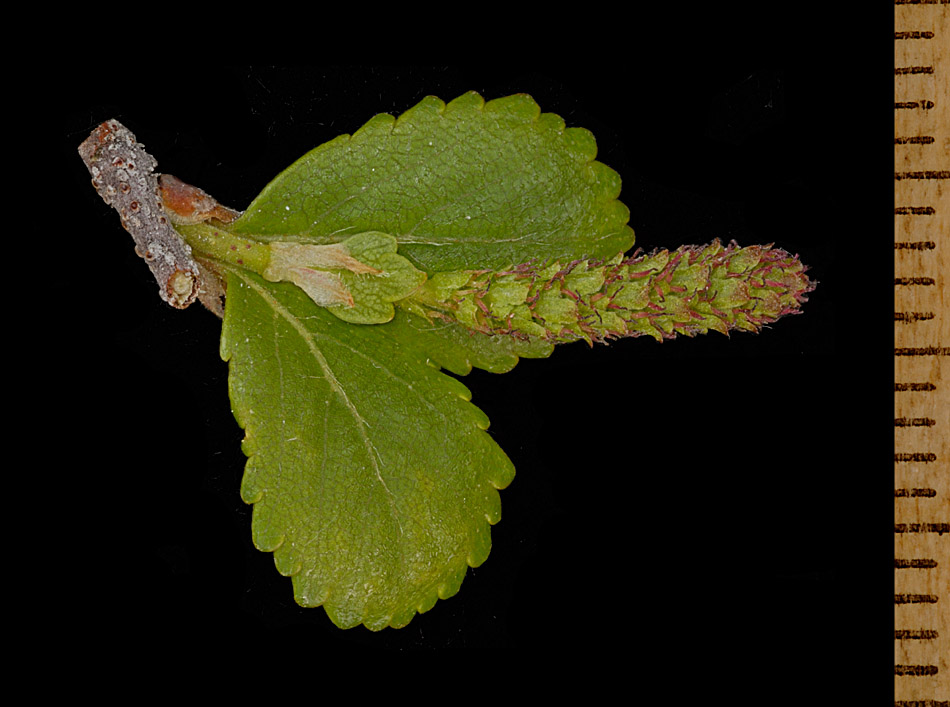 | Pumila: Answers
to key questions in Conifers & Catkin-Bearing Trees and Shrubs of
Saskatchewan, Fascicle 5, Flora of Saskatchewan by Anna Leighton leading
to this species. The answers are in the order you would normally work
through the key.
 |
Shrubs or
small trees to 10 m tall; bark of mature main stems darker, usually
reddish brown, not readily peeling off (tight); lenticels on older bark
inconspicuous or conspicuous and expanded horizontally up to 5 (10) mm.
NOT [Trees, 10 – 30 m tall; bark of mature trunks and branches usually
creamy, chalky white, pinkish white or pale reddish, readily peeling off
in sheets (strongly exfoliating); lenticels on older bark conspicuous,
expanded horizontally up to 15 (20) mm] |
 |
Shrubs to
4 m tall; leaf blades broadly ovate, obovate, orbicular or elliptic;
blade apices broadly acute, obtuse, rounded or truncate; blade margins
usually crenate, sometimes crenate-serrate; petioles usually <= 5 mm;
samara wings narrower than the body; scales 2 – 4 mm, central lobe
rounded to truncate at tip; lenticels on older bark inconspicuous.
NOT [Tall shrubs or small trees to 10 m tall; leaf blades broadly ovate
to rhombic-ovate; blade apices acute or occasionally short-acuminate;
blade margins serrate to irregularly double-serrate; petioles >= 5mm;
samara wings (at least one of the wings) equal to or wider than the
body; scales 4 – 5 mm, central lobe acute at tip; lenticels on older
bark conspicuous, distinctly expanded horizontally] |
 |
Leaf
blades 2.5 – 5 (7) cm, obovate, nearly orbicular or elliptic;
branchlets with small resinous glands; fruiting catkins short and wide,
0.8 – 1.5 (2) cm long, 0.8 – 1 cm wide; scales often with 3
light-colored lines on the inner (adaxial) surface. NOT [Leaf blades 0.5
– 2 (3) cm, broadly ovate, obovate to broadly orbicular; branchlets
with small or large resinous glands; fruiting catkins may be wider (up
to 2.5 long) or as narrow as 0.5 cm wide; scales usually uniform in
color on the inner (adaxial) surface]
|
|
 | Betula: Answers
to key questions in Conifers & Catkin-Bearing Trees and Shrubs of
Saskatchewan, Fascicle 5, Flora of Saskatchewan by Anna Leighton leading
to this genus. The answers are in the order you would normally work
through the key.
 |
Fruit a
samara, much shorter than 1 cm and subtended by a flat scale; bud scales
and bracts of staminate catkins not coarsely hairy; pistillate catkins
many-flowered, erect or pendulous, often borne on short shoots proximal
to the staminate catkins. NOT [Fruit a nut over 1 cm long, enclosed in a
tube-like involucre; bud scales and bracts of staminate catkins with
coarse, straight, appressed hairs; pistillate catkins few-flowered and
borne on short bud-like branches that are distal to the staminate
catkins and visible primarily as reddish styles projecting from the bud
at anthesis] |
 |
Branchlets
and young branches sparsely to densely covered with raised, round,
translucent resinous glands (resinous glands may be absent in B.
papyrifera, a tree with white bark exfoliating in sheets); woody
cone-like fruiting catkins not present on branches at any season; scales
of pistillate catkins deciduous, 3-lobed, not greatly thickened toward a
truncate apex. NOT [Branchlets and young branches lacking resinous
glands; woody cone-like fruiting catkins persisting on branches even in
winter; scales of pistillate catkins persisting on the catkin after
samaras have fallen, 5-lobed, greatly thickened towards a +/- truncate
apex] |
|

